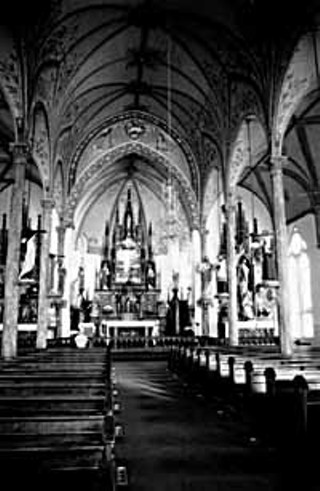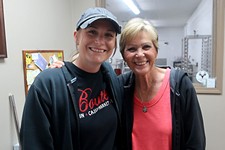Day Trips
The Painted Churches of Fayette County.
By Gerald E. McLeod, Fri., March 9, 2001

The Painted Churches of Fayette County are as inspiring as they are beautiful. The little country churches may not compete with the grand frescoes of Europe, but when combined with the spring beauty of Texas wildflowers they create a colorful mosaic.
In the fertile rolling hills between Houston and San Antonio about an hour and a half from Austin, Fayette County was settled by German and Czech immigrants beginning in the 1850s. As the small family farms prospered, so did the communities. More than 150 years later many of the farms are in the same families. The Old World traditions and even the language survive in pockets around the countryside.
For generations the interior beauty of the churches was a well-kept secret of the local parishioners. In the late 1980s, an elderly priest was conducting occasional tours of the churches, and the Schulenburg Chamber of Commerce soon began publicizing the hidden artistry. The chamber provides guided tours as well as maps for self-guided tours to the four churches in the area.
The church at High Hill is about three miles northwest of Schulenburg and is one of the most beautiful. The church's 111-foot steeple comes into view from High Hill Road as it winds through the countryside off U.S. 77. St Mary's Catholic Church was once the center of a thriving settlement that included a brewery, five blacksmith shops, three saloons, a dance hall, stagecoach stop, and several other businesses. When the railroad went through Schulenburg, the town all but moved with it.
From the outside the red brick building is a stately example of Gothic revival architecture reminiscent of European cathedrals. Illuminated by the bright colors of the stained glass windows, the soft colors of the arches and paintings of angels draw the eyes of the congregation toward heaven. The magnificent hand-carved wood and glass altar is a sight to see by itself.
Completed by a pair of San Antonio mural artists in 1912, the craftsmanship of the paintings is stunning. Along with traditional religious symbols, the sanctuary's wooden pillars are painted to look like they are made of marble.
Saints Cyril and Methodius Catholic Church in Dubina is elegant in a simple, understated way. The white, wooden church is around the bend from a scenic crossing of the Navidad River. The wrought-iron cross topping the steeple was made by a former slave and was rescued from the 1877 church that was destroyed in a 1909 storm.
In a thicket of oak trees, Dubina is a variation on the Czech word for oak. Although the name of the artist has been lost to time, the work is timeless, with arches outlined in ivies, flowers, and trailing oak leaves. A noticeable difference between this church's mural and others is the brighter hues of the paints that look fresh and new. That's because the designs were repainted in the 1980s.
In a move that now seems almost reprehensible, the congregation painted over the artwork in 1952 for the settlement's diamond jubilee celebration. In 1981, a former altar boy convinced the parishioners to uncover and restore the art. Using alcohol, cotton swabs, some of the original stencils, and a little creativity, the beautiful paintings came back to life around a sky blue ceiling.
Dubina is at the intersection of County Road 480 and FM 1383 northeast of Schulenburg. From U.S. 77, take FM 615 (the eastbound portion of High Hill Road), the road turns into a county road and then finds FM 1383 after crossing the river.
Saint John the Baptist Catholic Church in Ammannsville is accented by its reflection in a pond. According to Father Alan Oakes, who worked on The Painted Churches of Texas special with KLRU, the Pepto-Bismol pink walls and ceiling, heavenly murals with stenciling, and marbelized columns were painted around 1919 by Fred Donecker, who has vanished from historical records (he also painted frescoes at the church in Moravia).
The community's second church was destroyed in the same 1909 hurricane-spawned storm that wrecked the Dubina church. Parishioners managed to save the church's statues and crucifix. According to Old World traditions, the men sat on the right side of the church and the women on the left during worship services. The saints depicted in the stained glass windows also followed this ritual.
Ammannsville is about five miles north of Dubina on FM 1383. It can also be reached from U.S. 77 by taking FM 1383 east off of U.S. 77 just north of Swiss Alp.
St. Mary's Church of the Assumption in Praha is the only one of the four "Painted Churches" south of I-10. Founded in 1854, the settlement was first called Mulberry and then an unsavory crowd dubbed it Hottentot. When the Czech immigrants arrived they renamed the town Praha, which is Czech for "Prague."
The stone church was dedicated in 1895 with murals by Swiss-born painter Godfrey Flury. The artist was famous for painting opera house stages in New York, California, and San Antonio, but this is one of his surviving masterpieces. The ceiling is decorated with symbols, angels, gold scrolls, vines, and 66 different types of flowers and shrubs (but no bluebonnets). Behind the altar he painted Prague's main cathedral, St. Vitus, and an important Moravian convent. Remarkably, no part of the painting has ever needed to be retouched.
Praha is about three miles east of Flatonia and about a mile south of U.S. 90 on FM 1295.
According to Father Oakes' research, there are more than 20 painted churches around Texas. They vary from simple to elaborate. For more information, visit www.klru.org/paintedchurches/. For additional information, visit www.lagrangetx.org and www.schulenburgchamber.org. The Schulenburg Chamber of Commerce at 101 Kessler Ave. offers brochures and maps to the churches and can be reached at 979/743-4514. When visiting these and other historic churches remember that they are houses of worship and you should never enter the altar area. Most of the churches have donation boxes near the doors to help with the expensive upkeep.
Coming up this weekend ...
Parade of Quilts displayed in downtown Flatonia, through March 31. 361/865-3920.
Butterfly Gardening Show at the Butterfly Ranch in Fredericksburg demonstrates planting methods to attract the colorful insects, March 10-11. 830/990-0735 or www.livebutterfly.com.
Coming up ...
Dallas Video Festival showcases the work of independent artists at the Dallas Theater Center, March 14-18. 214/999-8999 or www.videofest.org.








